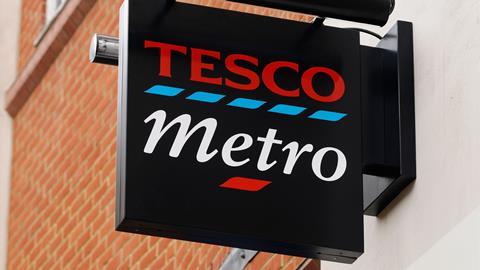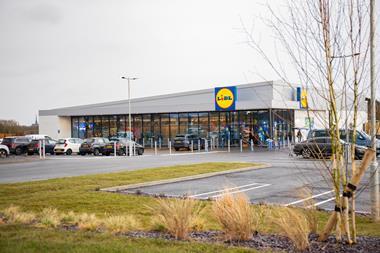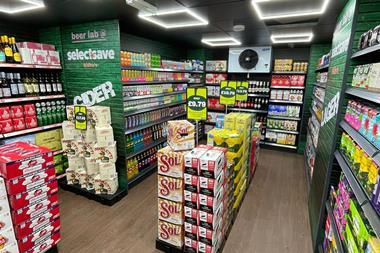Job cuts and store overhauls are due for Tesco’s 153 Metro stores
Residents in the UK’s easternmost town of Lowestoft expressed dismay earlier this month when Tesco announced it would be closing the doors of its Metro store in September.
‘Let’s face it - this town is dead,’ was the reaction on Twitter from one of those affected.
But is the same true for the Metro format itself, after it was revealed it faces a huge overhaul and the loss of 4,500 jobs?
The Metro brand, currently boasting 153 stores or around one million sq ft of space, is set for huge changes, as Tesco looks to ramp up the profitability of its stores and adapt to shopping patterns shot to pieces by the rise of the discounters.
Tesco has indicated the overhaul will affect ranging (with a much reduced lineup), as well as major changes to staff working hours and the slashing of layers of store management, with a focus on workers becoming all-rounders.
It promises “faster and simpler” ways of filling shelves, fewer products being stored in back rooms and more stock going straight to the shop floor.
The Grocer has learnt the moves will include arming Metro staff with new headsets to improve communication about where they are needed, as well as the use of “capping shelves”, which house stock at the top of shelves rather than in warehouses to reduce workload. Tesco insists it can make the changes without damaging its customer service because it is “following the way in which customers shop”.
But it’s not just the impact on service but the long term viability of the Metro format which has been troubling Tesco bosses.
How can Tesco maintain the customer experience with 4,500 job cuts?
At a Capital Markets Day in June, UK CEO Jason Tarry admitted Metro had a long-running identity crisis. Having originally been launched as a town centre location that could handle passing trade as well as weekly shops, Tesco’s own research shows nearly 70% of its Metros are now being used for top-up shops and food to go. Less than a third (31%) are typically being used for main shops.
As Shore Capital analyst Clive Black, one of those at the event, says: “Metro has became a jack of all trades and a master of none.”
At June’s presentation, Tarry revealed a trial at one unnamed Metro store had shown huge improvement in gross margins (up to 400 basis points) by changing the service model to dramatically slash the range and bring in simpler levels of price and promotions.
“I would expect space, range and backrooms at Tesco’s Metro estate to be realigned with the more limited shopping missions,” says Bruno Monteyne, senior analyst at Bernstein. “Simply having a more focused range, in easier-to-fill planograms, will make it a lot more productive. The more range you have to fill, the less productive you become.”
Revamping Metro
“Staffing hours link very close to range-complexity. So having less staff does not mean less service. It will clearly mean different ranges and modified lay-outs but by having those new ranges, it becomes easier to operate.”
But gearing the Metro estate to convenience and food to go will require more than simply rebadging Metro stores as Express, much as Tesco might like to do so. With the average Metro being around 11,000 sq ft compared with 2,000 sq ft for an Express, Tesco faces a much more complicated mission.
Longer term, Tesco admits it is looking at a host of potential evolutions to its store model. In Metro’s case this could include bringing in new F&F outlets, as well as new third-party partners from food-to-go businesses to fashion retailers.
Booker has also been touted as a potential player in the new-look Metros. Already around 100 larger Tesco stores offer bulk packs of products supplied by Booker, and Tesco also plans to offer Booker services in a further 200 stores, which could fit nicely into those changing shopping patterns.
Metro in numbers
Year launched: 1994
Number of stores: 153
Total space: 1 million sq ft
Average size: 11,000 sq ft
Average staff number: 100
“Tesco sees Booker as high growth and it see Express as high growth, so it will be looking at how it can squeeze elements of both into its Metro format,” says Thomas Brereton, an analyst at Global Data.
But he believes the revamp will focus on the fast growing area of food to go, with Metros bringing in a wider range of ready meal offerings, salad bars and also other more experimental offerings.
“For example, they could have rotation pop ups rather than fixed stands in the stores. I think Tesco should look to see how it can make Metro’s more experiential, in a way that differentiates them from traditional retail stores.”
Of course, if Tesco’s announcement of its Metro jobs cull had happened a year ago, with the retailer then on the cusp of launching its much-hyped Jack’s budget chain, assumptions would have been very different. Some analysts predicted 100 or more Jack’s would launch to take on Aldi and Lidl, including in underperforming Metro locations.
Indeed, the latest Jack’s opened last week in a former Metro site in Walton, Liverpool. Yet the other most recent Jack’s opening - in Rawtenstall, Lancashire - appeared to take a new direction, operating more like a cash & carry. This would surely not fit with the 70% of Metro shoppers using the stores for food to go.
Indeed, it appears more likely Tesco would look to phase out bulk items from Metro’s, rather than gear them specifically towards them.
Monteyne says he would be surprised if Tesco, which is sticking to its prediction of 10-15 Jack’s stores by the end of this year, goes for a full rollout using the Metro estate.
“You can never exclude an experiment, ” he says. “But it would be exactly that: an experiment.”
Yet another kite flown by Dave Lewis and Tarry is the potential for Tesco to open dedicated Tesco Finest stores, which could work in some upmarket areas, but surely lack the scalability which is key to an operation like Tesco.
Before launching new experiments, Tesco needs to ensure it can carry off the latest cuts without disastrously impacting on service or staff morale - areas so crucial to the turnaround since Lewis came in.
As well as the cuts to Metro staff, there will also be slashed opening hours at more than 130 Express Stores and more streamlining measures at larger stores, yet to be specified.
“Every part of the business is being evaluated,” says Monteyne. “They are asking do consumers want it? can we do it economically? What is the best way to do it?
In the case of Metro, consumer needs have clearly changed and therefore there is a cheaper way of doing it.”
Cheapest, however, as Lewis and Tarry know well, does not always mean best.

























No comments yet